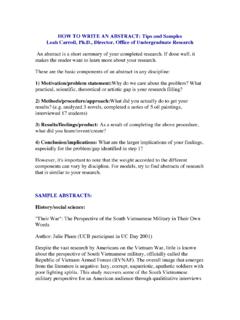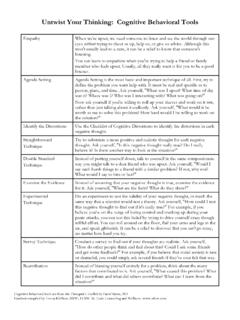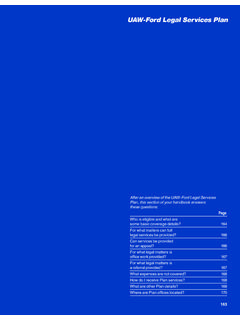Transcription of Bloom’s Taxonomy and Critical Thinking - Mariely Sanchez
1 Dolphins SEA Lab (Seeking Excellence through Advancement) Bloom s Taxonomy and Critical Thinking Benjamin Bloom (1956) developed a classification of levels of intellectual behavior in learning. This Taxonomy contained three overlapping domains: the cognitive, psychomotor, and affective. Within the cognitive domain, he identified six levels: knowledge, comprehension, application, analysis, synthesis, and evaluation. These domains and levels are still useful today as students develop their Critical Thinking skills. Critical Thinking involves logical Thinking and reasoning including skills such as comparison, classification, sequencing, cause/effect, patterning, webbing, analogies, deductive and inductive reasoning, forecasting, planning, hypothesizing, and critiquing.
2 Below you will find all six levels of Bloom s Taxonomy . The first three levels (knowledge, comprehension, and application) fall into the lower-order Thinking skills category. While the last three levels (analysis, synthesis, and evaluation) fall into the higher-order Thinking skills category. In each level you will find a brief description, key words, and question stems you can use to develop questions that will help increase your child s comprehension and Critical Thinking skills. Level 1: Knowledge exhibits previously learned material by recalling facts, terms, basic concepts and answers. Key Words: who, what, why, when, where, which, choose, find, how, define, label, show, spell, list, match, name, relate, tell, recall, select Questions: What How Where When did _____ happen?
3 How did _____ happen? How would you explain _____? Why How would you When Can you How would you Can you Who were the Can you list Which Who Source: M-DCPS - The Comprehensive Reading Plan Companion & Gifted Program Parent/Student Handbook 38 Dolphins SEA Lab (Seeking Excellence through Advancement) Bloom s Taxonomy and Critical Thinking Level 2: Comprehension demonstrating understanding of facts and ideas by organizing, comparing, translating, interpreting, giving descriptions and stating main ideas. Key Words: compare, contrast, demonstrate, interpret, explain, extend, illustrate, infer, outline, relate, rephrase, translate, summarize, show, classify Questions: How would you classify the type How would you What facts or ideas What is the main idea Which statements What is Can you explain what is Which is the best What can you say How would you Will you state in your own How would you rephrase the Level 3: Application solving problems by applying acquired knowledge, facts, techniques and rules in a different way.
4 Key Words: apply, build, choose, construct, develop, interview, make use of, organize, experiment with, plan, select, solve, utilize, model, identify Questions: How would you organize ____ to What would result How would you show your understanding What approach would you use What facts would you select to How would you What elements would you choose to What examples can you find What other way would you plan Can you make use of the facts What questions would you ask in an interview How would you apply what you learned to How would you solve ____ using what you have learned? Source: M-DCPS - The Comprehensive Reading Plan Companion Gifted Program Parent/Student Handbook 39 Dolphins SEA Lab (Seeking Excellence through Advancement) Bloom s Taxonomy and Critical Thinking Level 4: Analysis examining and breaking information into parts by identifying motives or causes; making inferences and finding evidence to support generalizations.
5 Key Words: analyze, categorize, classify, compare, contrast, discover, dissect, divide, examine, inspect, simplify, survey, take part in, test for, distinguish, list, distinction, theme, relationships, function, motive, inference, assumption, conclusion Questions: What are the parts or features How is _____ related Why do you What is the What motive is Can you list the What inference can you What conclusions can you How would you How would you Can you identify the different What evidence can you What is the relationship What is the function Can you make a distinction What ideas Level 5: Synthesis compiling information together in a different way by combining elements in a new pattern or proposing alternative solutions.
6 Key Words: build, choose, combine, compile, compose, construct, create, design, develop, estimate, formulate, imagine, invent, make up, originate, plan, predict, propose, solve, solution, suppose, discuss, modify, change, improve, adapt, minimize, maximize, delete, elaborate, test, improve, happen, change Questions: What changes would you make to How would you What would happen Can you elaborate on the Can you propose an Can you How could you change the How would you Can you predict the outcome How would you Suppose you could ___; what would you do? What facts can you How would you adapt ___ to create a How would you estimate the results Source: M-DCPS - The Comprehensive Reading Plan Companion Gifted Program Parent/Student Handbook 40 Dolphins SEA Lab (Seeking Excellence through Advancement) Bloom s Taxonomy and Critical Thinking Level 6: Evaluation presenting and defending opinions by making judgments about information, validity of ideas or quality of work based on a set of criteria.
7 Key Words: award, choose, conclude, criticize, decide, defend, determine, dispute, evaluate, judge, justify, measure, compare, mark, rate, recommend, rule on, select, agree, interpret, explain, appraise, prioritize, opinion, support, importance, criteria, prove, disprove, assess, influence, perceive, value, estimate, influence, deduct Questions: Do you agree with the Do you agree with the What is your opinion Would it be better What did the character How would you How would you How would you What choice would you have How could you How would you What would you What judgment would you make Why was it better How would you compare the Based on what you know, how would you What information would you use to support the Source: M-DCPS - The Comprehensive Reading Plan Companion Gifted Program Parent/Student Handbook 41











